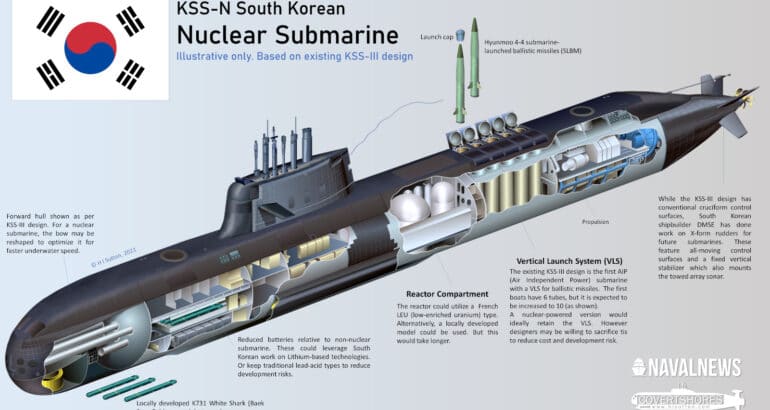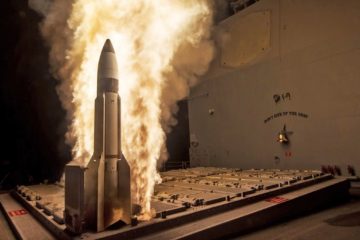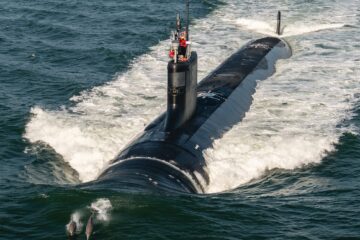More countries are turning to nuclear-powered submarines. The Royal Australian Navy began the AUKUS program this year. And the Brazilian Navy signed off construction of its SN-BR boat on November 25. Meanwhile defense analysts are watching another likely candidate in the atomic submarine game, South Korea.
On November 10 local media (in Korean) reported on plans to start work on an indigenous nuclear reactor. The multipurpose system is described in civilian terms. But observers have been quick to make the association to a South Korean Navy (ROKN) nuclear submarine program. (In naval terminology, nuclear submarine refers to the power plant, not the armament).
It is no secret that South Korea as an interest in building nuclear submarines. It has been an open discussion for nearly twenty years and AUKUS has only reinvigorated it. And South Korea now has the submarine building industry, and nuclear industry, to do it.
Motivations For The KSS-N Submarine
While AUKUS may be the most visible catalyst, it is not the reason that South Korea are interested in building a KSS-N (an unofficial term, referring to a Korean submarine with nuclear propulsion). The country faces a rapidly developing submarine threat from North Korea. The northern neighbor, with whom they are technically still at war, does not have nuclear submarines. But it is building nuclear armed conventional submarines. South Korea’s submarines are individually much more sophisticated. But they are not as capable at dealing with these threats as nuclear ones would be.
Nuclear submarines offer navies many advantages over regular diesel-electric boats. Primarily it allows them to travel at much higher speeds and for much longer. The submarine’s endurance, and thus combat persistence, is limited by the crew rather than the propulsion.
Diesel-electric submarines, which are the mainstay of South Korea’s submarine force, can operate for a few weeks at a time. When they return to base they are particularly vulnerable. Nuclear submarines can operate for several months, and cover a much larger areas.
South Korea’s current diesel-electric submarines are among the most capable and most sophisticated in the world. Many have German designed fuel cell AIP (air independent Power). Their KSS-III class is noteworthy as the first AIP equipped boat with a vertical launch system (VLS) for ballistic missiles. The missiles are, in this case, conventionally armed precision strike weapons.
And local manufacturers are working on an improved AIP system. This will have a methanol reformer, which promises to be safer, lighter and more compact. Meanwhile the country is likely to be one of the first to deploy the latest lithium-based batteries aboard submarines. A system is already being tested.
Yet, while these technologies reduce the gap between diesel-electric submarines and nuclear ones, and have their own tactical advantages, they are really not comparable. Nuclear submarines will still be faster, especially over longer distances. They will have much greater endurance and more power for other uses, like powerful sonar.
Potential International Partners For A South Korean SSN
South Korea could take the lonely path of truly indigenous project. But it would be faster and less risky to work with a country with existing experience. Like Australia, South Korea is looking to overseas partners with existing nuclear submarines for help. In their case the two obvious countries to consider are the US and France.
For many the natural partner is seen as the US, a strong ally of the country. Yet the US has been reticent to share nuclear propulsion technology, until AUKUS. Even with AUKUS, there does not seem to be any movement on this front, at least publicly.
There are a few challenges with South Korea using US reactors. American reactors currently use highly-enriched uranium. Transfer would not breach any treaties, but it would give the appearance of delivering weapon-grade uranium. Bad optics.
Additionally the U.S. Navy’s nuclear submarines are extremely large and expensive, likely beyond South Korea’s needs and ambitions.
Besides the US, South Korea has had an effective international procurement strategy. Germany, UK, France, and even Russia have provided modern technologies for their home-grown KSS-III submarine.
If South Korea were to use the KSS-III class as a basis for KSS-N, then France may be a more obvious primary partner. Their reactors use low-enriched uranium, like most civilian applications. Operationally this can be a disadvantage, as they need refueling more often. But politically, it is a strength.
France has been building nuclear submarines for decades and is helping Brazil with a similar project. In that case Brazil is designing and building the reactor, and France is helping with submarine design and integration. For KSS-N we might expect to see a French reactor.
France’s latest Suffren class submarine as a slightly larger hull diameter than KSS-III. Diameter is the most important dimension here because it dictates the physical size of the systems. It is possible maybe, that the French reactor could fit inside KSS-III hull however. The earlier Rubis class is much smaller still, demonstrating that nuclear propulsion does not necessarily require a physically large submarine.
KSS-III is relatively large for a non-nuclear submarine. The nuclear reactor could slot in, replacing the hull compartment currently used for AIP. Together with reducing the batteries, it might allow only a small increase in overall size. Naturally the exact arrangement of the propulsion machinery, and degree of sound insulation, may be a factor. But it is not hard to imagine a KSS-III based boat with a French reactor. Or French assistance wit a Korean reactor.
The idea that France could help South Korea with nuclear submarines has been raised by both countries. AUKUS, and the wider advances in the submarine fleets of Asian navies, can only help reinforce the idea.
South Korea has advanced submarine capabilities, and is increasingly self-sufficient for the fundamental aspects. A nuclear powered submarine does not appear out off reach.






